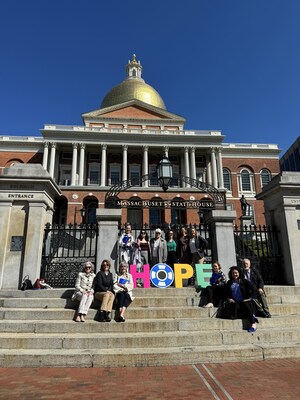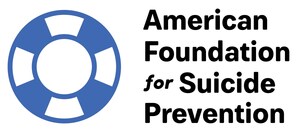News outlets are urged to use best practices for ethically reporting on suicide
NEW YORK, Sept. 12, 2024 /PRNewswire/ -- The following statement is from Dr. Christine Yu Moutier, Chief Medical Officer of the American Foundation for Suicide Prevention (AFSP):
We commend Jon Bon Jovi, his team, and the Nashville police for their life-saving actions on Tuesday. Everyone has a role to play in preventing suicide. Together, we can learn the suicide risk factors and warning signs, and encourage those who struggle to seek help.
Research has shown that the media plays a critical role in a public health approach to preventing suicide. How we talk about suicide in our society can influence the health outcomes of those who are vulnerable. We urge all media covering suicide in any instance, whether a death or an attempt, to focus on ethical reporting and to guide people to information and resources for help.
It is extremely important to take great care when reporting on structures, such as bridges, in relation to suicide. The risk for suicide contagion is possible when certain details such as images of locations of attempts or inclusion of potential lethal means are shared widely in media.
As a matter of public health, we ask that reporters covering bridge-related suicide attempts refrain from sensationalizing details that could contribute to suicide contagion. Including visual images of the location of an attempt, and particularly bridges which are used as a potential method for suicide, can be dangerous in reporting. Vivid imagery of the bridge and in a way that makes the specific location of the bridge identifiable or paints a picture of what the fall would look like can be harmful, therefore, we recommend avoiding any photos and videos of bridges in reporting.
Rather, focus on the hopeful message and the fact that suicide can be preventable. According to research, sharing stories of hope and recovery, along with mental health or crisis resources can reduce suicide contagion. Showing the manner in which people are overcoming their struggles can also be modeled, encouraging people to seek support to address their own struggles. It shows them that thriving is possible and engaging in support and treatment are helpful. Ethical reporting can ultimately be a protective factor for society to address this public health crisis.
Please reference our full recommendations here for responsibly reporting on suicide. To ethically and accurately cover suicide, the American Foundation for Suicide Prevention (AFSP) asks that media adhere to the following guidelines:
- Do not include details, images or video of lethal means or methods used, which can negatively affect those who are struggling and research has shown this to increase the likelihood of suicide contagion.
- Inform the audience without sensationalizing the suicide. Exclude images or graphic depictions of a suicide death, such as details and location of death, and avoid glamorizing the method used. While counterintuitive to do in newsrooms, it's important these details are minimized to the degree possible.
- Do not share notes left behind, which can create sensationalism and pose risk to vulnerable people.
- Do not refer to a suicide attempt as "successful," "unsuccessful" or as a "failed attempt," and do not use the word "committed." Instead, use "attempted suicide," "died by suicide" or "took his/her life."
- Avoid using sensationalist language in headlines and that indicate the method, and avoid using the word suicide in the headline. We also recommend considering the placement of stories within the media platform or newscast so as not to lead with or prominently place these stories on front pages or at the top of the newscast. Research shows that prominent placement of these stories increase the risk of suicide contagion.
- Avoid reporting that a suicide death was "caused" by a single event, such as a job loss or divorce, since research shows no one takes their life for one single reason, but rather a combination of factors (which you can learn about at afsp.org/signs). Reporting a single "cause" leaves the public with an overly simplistic and misleading understanding of suicide.
- Research shows suicide is a complex health issue. Therefore, especially when the individual has been open about experiencing a mental health condition, it can be helpful to frame the death in terms of a tragic health outcome the individual succumbed to.
- Always provide helpline information — "If you are in crisis, please call the Suicide and Crisis Lifeline at 988, or contact the Crisis Text Line by texting TALK to 741741."
We must do more to prevent tragic deaths through greater awareness of mental health, common risk factors and warning signs of suicide, and effective interventions and treatments. To learn more and view additional resources, visit our website at www.afsp.org.
The American Foundation for Suicide Prevention is dedicated to saving lives and bringing hope to those affected by suicide, including those who have experienced a loss. AFSP creates a culture that's smart about mental health through public education and community programs, develops suicide prevention through research and advocacy, and provides support for those affected by suicide. Led by CEO Robert Gebbia and headquartered in New York, with a public policy office in Washington, D.C., AFSP has local chapters in all 50 states, D.C. and Puerto Rico, with programs and events nationwide. Learn more about AFSP in its latest Annual Report and join the conversation on suicide prevention by following AFSP on Facebook, Twitter, Instagram, YouTube, LinkedIn and TikTok.
SOURCE American Foundation for Suicide Prevention

WANT YOUR COMPANY'S NEWS FEATURED ON PRNEWSWIRE.COM?
Newsrooms &
Influencers
Digital Media
Outlets
Journalists
Opted In






Share this article